The AMD Radeon R9 290 Review
by Ryan Smith on November 5, 2013 12:01 AM EST- Posted in
- GPUs
- AMD
- Radeon
- Hawaii
- Radeon 200
Compute
Jumping into pure compute performance, this is another scenario where the 290X shouldn’t throttle as much, and as such the performance differences between the 290 and 290X should be closer to what they are on paper. With compute workloads the ROPs aren’t being hit hard, so that’s power and thermal savings that lets both cards operate at close to their maximum boost clocks.
As always we'll start with our DirectCompute game example, Civilization V, which uses DirectCompute to decompress textures on the fly. Civ V includes a sub-benchmark that exclusively tests the speed of their texture decompression algorithm by repeatedly decompressing the textures required for one of the game’s leader scenes. While DirectCompute is used in many games, this is one of the only games with a benchmark that can isolate the use of DirectCompute and its resulting performance.
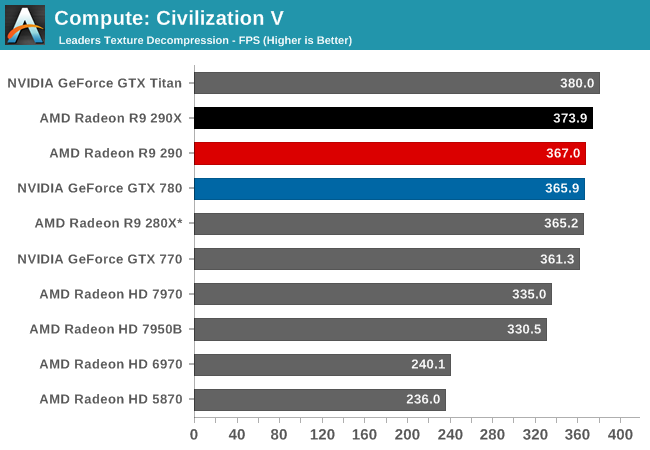
As with the 290X, Civ V can’t tell us much of value due to the fact that we’re running into CPU bottlenecks, not to mention increasingly absurd frame rates. The 290 is marginally slower than the 290X due to the lower clockspeeds and missing CUs, but minimally so.
Our next benchmark is LuxMark2.0, the official benchmark of SmallLuxGPU 2.0. SmallLuxGPU is an OpenCL accelerated ray tracer that is part of the larger LuxRender suite. Ray tracing has become a stronghold for GPUs in recent years as ray tracing maps well to GPU pipelines, allowing artists to render scenes much more quickly than with CPUs alone.
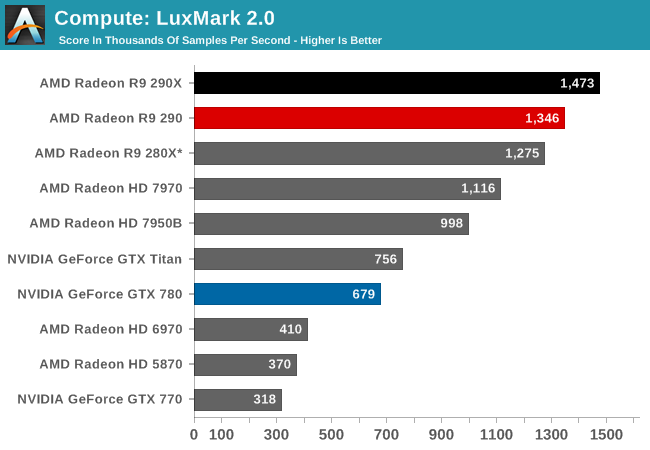
With both cards unthrottled and bound solely by shader performance, it’s an outright foot race for the Radeon cards. 290 trails 290X by around 9%, closely mirroring the difference in the CU count between the two cards. Though 290 is being very closely chased by the 280X, as Hawaii in general seems to have trouble getting the most out of its shader hardware on this benchmark.
Our 3rd compute benchmark is Sony Vegas Pro 12, an OpenGL and OpenCL video editing and authoring package. Vegas can use GPUs in a few different ways, the primary uses being to accelerate the video effects and compositing process itself, and in the video encoding step. With video encoding being increasingly offloaded to dedicated DSPs these days we’re focusing on the editing and compositing process, rendering to a low CPU overhead format (XDCAM EX). This specific test comes from Sony, and measures how long it takes to render a video.
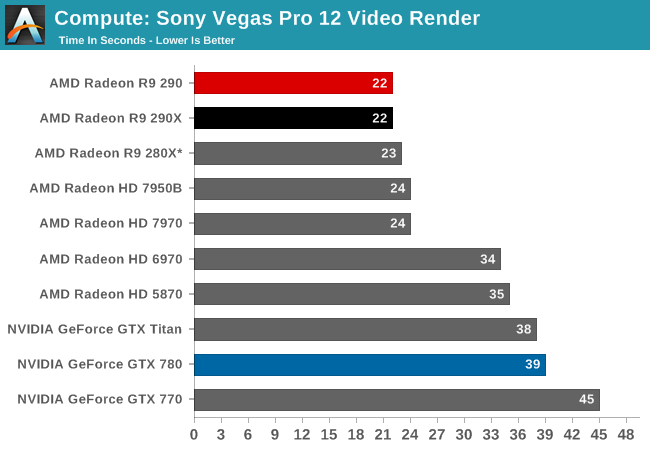
There’s not enough of a GPU performance difference between the two cards to matter with this test. Both tie at 22 seconds.
Our 4th benchmark set comes from CLBenchmark 1.1. CLBenchmark contains a number of subtests; we’re focusing on the most practical of them, the computer vision test and the fluid simulation test. The former being a useful proxy for computer imaging tasks where systems are required to parse images and identify features (e.g. humans), while fluid simulations are common in professional graphics work and games alike.
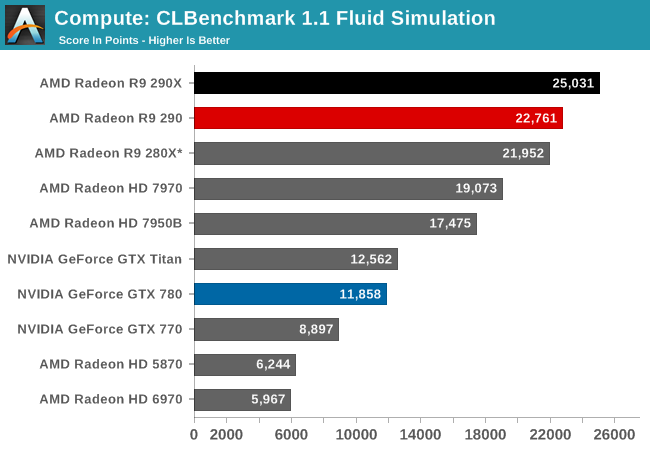

In the CLBenchmark fluid simulation the 290X and 290 take the top spots as expected, with the 290 trailing once more by 9%. However both Hawaii cards are still struggling with the computer vision benchmark, leading to the 290 being edged out by the 7970 of all things.
Moving on, our 5th compute benchmark is FAHBench, the official Folding @ Home benchmark. Folding @ Home is the popular Stanford-backed research and distributed computing initiative that has work distributed to millions of volunteer computers over the internet, each of which is responsible for a tiny slice of a protein folding simulation. FAHBench can test both single precision and double precision floating point performance, with single precision being the most useful metric for most consumer cards due to their low double precision performance. Each precision has two modes, explicit and implicit, the difference being whether water atoms are included in the simulation, which adds quite a bit of work and overhead. This is another OpenCL test, as Folding @ Home has moved exclusively to OpenCL this year with FAHCore 17.
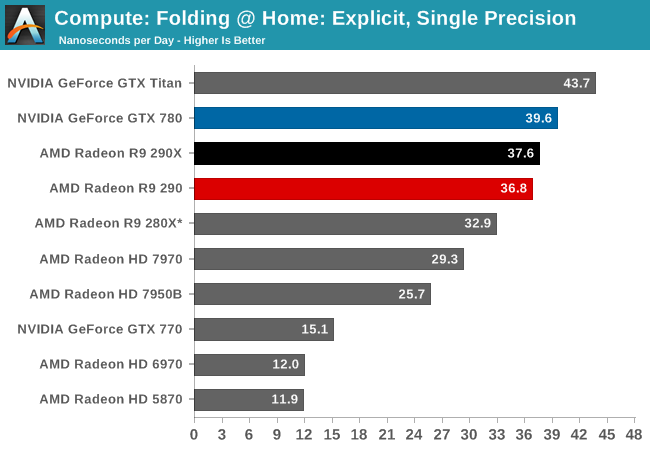
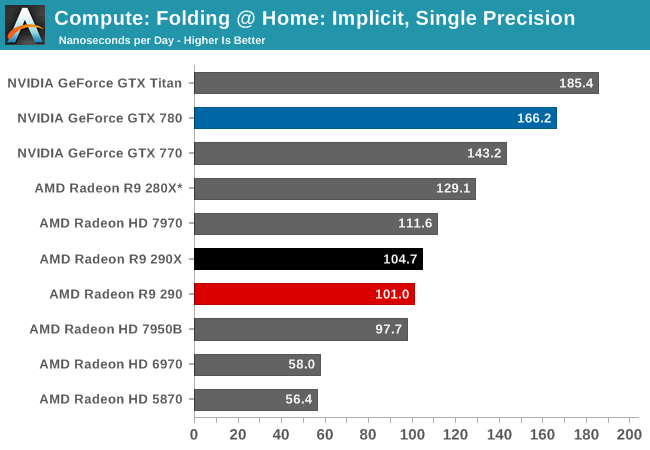
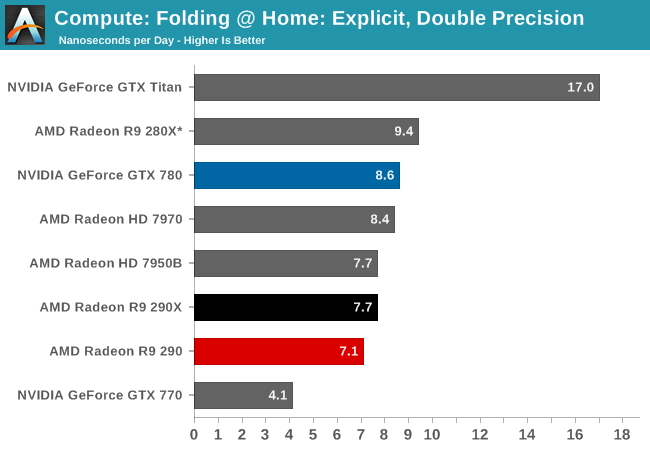
Generally Tahiti and Hawaii are strong performers in the GPU compute arena, but that isn’t of particular help to the 290 here, as it loses out to the GTX 780 in every mode. In single precision FAHBench has trouble putting Hawaii to good use at times, while double precision tests have the 1/8th DP rate 290 and 290X falling behind due to their lower than Tahiti DP throughput.
Wrapping things up, our final compute benchmark is an in-house project developed by our very own Dr. Ian Cutress. SystemCompute is our first C++ AMP benchmark, utilizing Microsoft’s simple C++ extensions to allow the easy use of GPU computing in C++ programs. SystemCompute in turn is a collection of benchmarks for several different fundamental compute algorithms, as described in this previous article, with the final score represented in points. DirectCompute is the compute backend for C++ AMP on Windows, so this forms our other DirectCompute test.
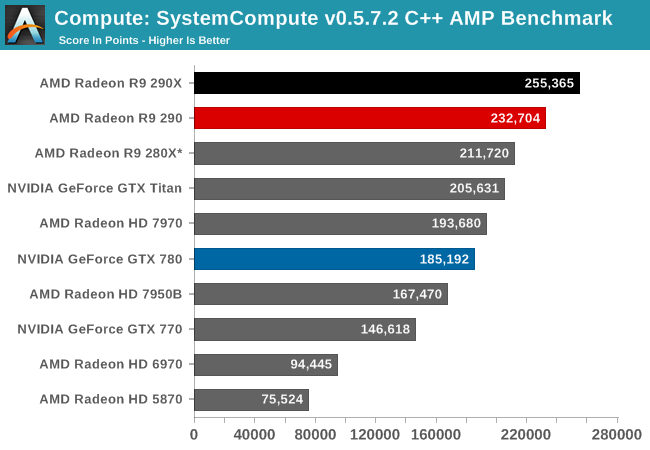
SystemCompute is another benchmark where 290 and 290X do not experience meaningful throttling, and as such are separated by more than what happens in our gaming benchmarks. In this case 290 yet again trails 290X by 9%, though it still enjoys a considerable lead over the GTX 780 and all other NVIDIA cards.










295 Comments
View All Comments
TheJian - Tuesday, November 5, 2013 - link
Simple economics...NV doesn't make as much as they did in 2007. They are not gouging anyone and should be charging more (so should AMD) and neither side should be handing out free games. Do you want them to be able to afford engineers and good drivers or NOT? AMD currently can't afford them due to your price love, so you get crap drivers that still are not fixed. It's sad people don't understand the reason you have crap drivers is they have lost $6Billion in 10yrs! R&D isn't FREE and the king of the hill gets to charge more than the putz. Why do you think their current card is 10db’s higher in noise, 50-70 watts higher and far hotter? NO R&D money.NV made ~550mil last 12 months (made $850 in 2007). Intel made ~10Billion (made under 7B 2007, so profits WAY UP, NV way down). Also INtel had 54B in assets 2007, now has 84billion! Who's raping you? The Nvidia hate is hilarious. I like good drivers, always improving products, and new perf/features. That means they need to PROFIT or we'll get crappy drivers from NV also.
Microsoft 2007=14B, this year $21B (again UP HUGE!)
Assets 2007=64B, 2013=146Billion HOLY SHITE.
Who's raping you...IT isn't Nvidia...They are not doing nearly as well as 2007. So if they were even raping you then, now they're just asking you to show them your boobs...ROFL. MSFT/INtel on the other hand are asking you to bend over and take it like a man, oh and give me your wallet when I'm done, hey and that car too, heck sign over your house please...
APPLE 2007=~3Bil profits 2013=41Billion (holy 13.5x the raping).
Assets 2007=25B, wait for it...2013=176Billion!
bend over and take it like a man, oh and give me your wallet when I'm done, hey and that car too, heck sign over your house please...Did you mention you're planning on having kids?...Name them Apple and I want them as slaves too...LOL
Are we clear people. NV makes less now than 2007 and hasn't made near that 850mil since. Why? Because market forces are keeping them down which is only hurting them, and their R&D (that force is AMD, who by the way make ZERO). AMD is killing themselves and fools posting crap like this is why (OK, it's managements fault for charging stupidly low prices and giving out free games). You can thank the price of your card for your crappy AMD drivers
Doesn't anyone want AMD to make money? Ask for HIGHER PRICES! Not lower, and quit demonizing NV (or AMD) who doesn't make NEAR what they did in 2007! Intel killed their chipset business and cost them a few hundred million each year. See how that works. If profits for these two companies don't start going up we're all going to get slower product releases (witness what just happened, no new cards for 2yrs if you can even call AMD's new as it just catches OLD NV cards and runs hot doing it), and we can all expect CRAP DRIVERS with those slower released cards.
AMD finally made a profit in the last year 1/2 this Q (only 48mil and less depending on if you look gaap, non-gaap). AMD has lost over 6Billion in 10yrs. They are not charging you enough. I expect them to lose money again as they owe $200mil to GF Dec 31st which will wipe out last Q profit and kill this Q also. See the point? They need to make money. How is it possible for either side to be ripping us off if neither has made as much as they did in 2007 for 6 years with AMD losing their collective ARSE?
I could give you the Hard Drive makers profits etc and would show the same (or worse) as MS, Apple, Google. The flood allowed them all triple profits (quad in Seagates case). YES, this is ripping us off.
Spunjji - Tuesday, November 5, 2013 - link
TL;DRSenti - Tuesday, November 5, 2013 - link
Good drivers from NV? Ha-ha-ha! You've never run anything besides few overhyped games I guess. They are awful the moment you start programming them:You use some obscure feature of standard that is not used in games? Here, have a bluescreen! Even AMD video drivers weren't so bad recently.
File in bug report? Ignored, who cares about you, you are not making one of top tier games.
Want OpenCL 1.2 like the rest of the world has (even integrated Intel videocards)? No, it's not important – here you are ten new versions of CUDA!
And how about crippled OpenGL for non-Quadro cards? Sure I know what I'm talking about since I have Quadro too.
dragonsqrrl - Monday, November 11, 2013 - link
Your comment is nothing but an exercise in ambiguity. So basically what you're saying is that because Nvidia's drivers don't work perfectly for every user, AMD's drivers are superior. Really?The one sentence that's actually applicable to gaming is just about as vague as you can get, maybe because you don't actually know what you're talking about? Bluescreen, really? Okay... And from an end user perspective wtf does it even mean to program a driver? Are you suggesting you're something more than an end user? Are you suggesting you work for Nvidia? lol...
Whatever driver related bsod problems you were having is unlikely to be systemic, and may not even be driver related at all. Almost all of the Nvidia driver issues I've read about in recent memory (past couple of years) have been isolated incidents that may result in instability for certain users, none of which I've experienced myself (GTX480). Optimizations compared to the competition have been spot on, and title support has been fantastic. The only exception I can think of was the fan controller issue a couple years ago. Compare that to AMD's recent driver issues (xfire, surround, 4k, frame pacing, etc), all of which are systemic and widespread. I think most AMD fanboys choose to either ignore these problems, or accept them as the norm (same with fan noise on stock coolers), which is stupid and self defeating in my opinion. That sort of attitude doesn't drive AMD or Nvidia to improve.
Senti - Wednesday, November 13, 2013 - link
I'm talking from developer's point, can you even read? You probably have no clue about programming if those sounded ambiguous and you even suggested that I work for NV, lol.I don't say that AMD's drivers are superior, but I can surely say that "NV drivers are superior" is one big lie. They are both bad, really.
I can tell you some fun things about AMD's drivers too: like, uploading textures of certain sizes crashes them, or how their OpenCL compiler crashes on certain C99 features. But those are just program-level crashes (not system-level) and I see texture crash only in recent beta versions, not the last stable version; haven't really investigated OpenCL ones. On the other hand I can reliably send NV drivers into bluescreen, but as already said, it's quite obscure feature and simple users have very low chance to stumble upon it.
Conclusion: we do love AMD for their performance/price ratio while there is nothing to love NV for except being mindless fanboy. My personal view of current situation, feel free to disagree.
nsiboro - Wednesday, November 6, 2013 - link
TL;DRNvidia isn't doing only GPU. Do not forget Tegra - acquisition of comm IP, etc. do require $$$.
The raping is true.
GPU revenue dump into ARM/mobile for future survival.
Drumsticks - Tuesday, November 5, 2013 - link
I like how they actually explicitly recommend against the card and the first 5 comments are praising it XD.That's a LOT of noise... but when we get custom coolers this will be really, really exciting.
RussianSensation - Tuesday, November 5, 2013 - link
Yup, customs coolers will fix both the noise levels and temperature issues. After that, this card will be a must buy. 2 Windforce 3x (dual slot) and $699 780Ti is irrelevant. In fact, after-market versions of R9 290 will make 780/R9 290X and 780Ti very overpriced. They can't get here soon enough.dragonsqrrl - Tuesday, November 5, 2013 - link
Well, sometimes you just can't fix fanboism.Tetracycloide - Tuesday, November 5, 2013 - link
How puerile.